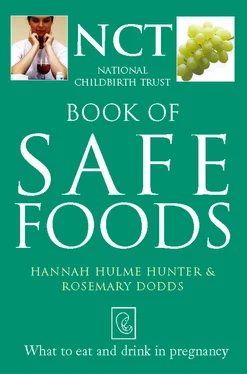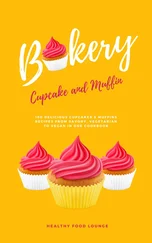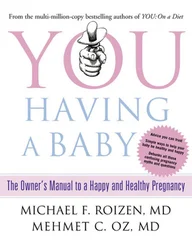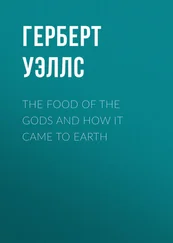Sugary carbohydrate are found in foods such as sweet biscuits, cakes, jellies, puddings and sweets. These foods are not very filling and they can be expensive to buy. Sugary carbohydrates give us a quick boost of energy, but this energy is only short-lasting so we are likely to feel hungry again soon afterwards.
Sugary carbohydrates have very little nutritional value. This is why it is best not to eat too many sugary foods. It is far better to eat plenty of the starchy carbohydrate foods mentioned above – foods that give us more than just energy. We talk more about sugary foods a little later in this chapter.
Generally, wholemeal or brown varieties of rice, pasta, cereals and bread tend to contain more vitamins, minerals and fibre than the refined or white kinds. For example, wholemeal bread contains half as much again of some of the important B group of vitamins than the same amount of white bread – and twice as much fibre. Wholemeal foods are very useful during pregnancy, when sometimes you may not feel like eating much, because even a relatively small quantity of a wholemeal food will still give you plenty of energy and other nutrients.
Wholemeal breakfast cereals are especially good value in nutritional terms. All breakfast cereals are good energy foods, and most are fortified. (Fortified means that extra vitamins or iron have been added.) Wholemeal cereals are also particularly rich in fibre. Add milk, maybe a few pieces of fresh or tinned fruit, and you have a balanced, get-up-and-go breakfast. Many people enjoy breakfast cereals at other times of the day, too.
How much starchy carbohydrate?
Along with fruit and vegetables, starchy carbohydrates make up the bulk of a balanced diet. Try to include some starchy foods in each meal – and aim for a total of six servings throughout the day. A ‘serving’ of starchy carbohydrates is equivalent to:
 2 large slices of bread
2 large slices of bread
1 large bread roll, a pitta or a nan
 2 Weetabix
2 Weetabix
a large bowl of breakfast cereal ‘flakes’
a large bowl of porridge
2 fist-sized potatoes or 2 pieces of yam
a portion (about 6 tablespoons) of cooked pasta
 a portion (about 4 heaped tablespoons) of rice
a portion (about 4 heaped tablespoons) of rice
Minerals are inorganic (not living) nutrients found naturally in many foods. Iron, calcium and zinc are examples of important minerals. Minerals are necessary for many body functions, including control of the balance of fluids in our bodies, as well as strong bones and teeth. As with vitamins, it is best to get minerals from our food, rather than take supplements.
Vitamins are special substances that our bodies need in order to function normally. Vitamins occur naturally in many foods – but no single food contains all vitamins except breast milk. Only one vitamin (vitamin D) can be made within our bodies – most have to be obtained from our food. Some vitamins can be stored in our bodies while others need to be eaten each day. We only need very small amounts of each vitamin. It is best to get vitamins from our food, rather than from supplements (except for folic acid). Too much vitamin A can be harmful during pregnancy.
Why are vegetables and fruit so important?
The next third of our plate is filled with vegetables and fruit. These foods are bursting with valuable nutrients including vitamins (especially vitamin C and folic acid) and minerals. Fruit and vegetables are our main source of antioxidants – special chemicals found naturally in foods that help protect our bodies against heart disease, cancer and the effects of pollution.
Fruit and vegetables are also a good source of fibre. Fibre (also found in cereals) is the part of our food that is not digested by our bodies. It passes through our digestive system and makes up the bulk of our faeces (bowel motion or poo). Fibre plays an important part in keeping our digestive systems running smoothly and preventing bowel diseases. If we do not have enough fibre in our diet, we may become constipated (have difficulty in passing a bowel motion).
Shopping for fruit and vegetables
If you can, buy fresh fruit and vegetables. Green leafy vegetables are good sources of folic acid. Yellow fruit such as mangoes and apricots, and citrus fruits such as oranges and grapefruits, are rich in vitamin C. But the main thing is to choose fruit and vegetables that you enjoy – and eat plenty!
Try to choose clean, undamaged items, store in a cool place and wash them well at home. Fruit and vegetables sold loose tend to be cheaper than trimmed and packaged items. Some market stall holders and green grocers sell their produce off at reduced prices at the end of the shopping day. Eat fruit and vegetables within a few days, while they are still fresh. And remember that over-cooking of vegetables will greatly reduce their vitamin content – and spoil their taste.
How much vegetables and fruit?
We cannot eat too much fruit and too many vegetables! We should all aim to eat five servings each day. A serving of fruit and vegetables is equivalent to:
 a piece of fruit – one apple, a single banana, a large slice of melon and so on
a piece of fruit – one apple, a single banana, a large slice of melon and so on
 12 chunks of tinned pineapple
12 chunks of tinned pineapple
a small glass of unsweetened fruit juice
 a large bowl of salad
a large bowl of salad
a large tomato
 3 tablespoons of peas
3 tablespoons of peas
2 tablespoons of carrots or cabbage
a handful of raisins
vegetable curry or vegetable stir-fry (counts as two servings if eaten as a main meal)
Protein foods fit into one of the smaller sections of our plate. This may surprise some people. The traditional approach to English meal planning tended to over-emphasise our need for protein – especially for meat protein. Nutritionists now know that we do not need as much protein as previously thought.
But protein is still a very important part of our diet. We need it to repair and maintain the basic building blocks of our bodies – our cells. We also need it to grow new cells; in particular, we need protein while pregnant to grow our babies. We need protein, too, to grow new blood cells and to produce antibodies (the special cells that help our bodies fight infection). Meat protein, in particular, is rich in valuable minerals such as iron and zinc. We talk more about these nutrients in Chapter 2.
Protein comes from two food sources – animal and vegetable. Whatever the source, the basic component of protein is the amino acid. There are many different amino acids. Our bodies can make some, but most need to be taken in our diet. The balance of amino acids in animal protein (in meat, milk and eggs) is similar to the balance required by our bodies. The balance of amino acids in vegetable protein (in nuts and lentils, for example) varies from food to food. This is why people who do not eat meat or drink milk need to eat a wide range of vegetable protein in order to get a good balance of amino acids.
Читать дальше

 2 large slices of bread
2 large slices of bread










